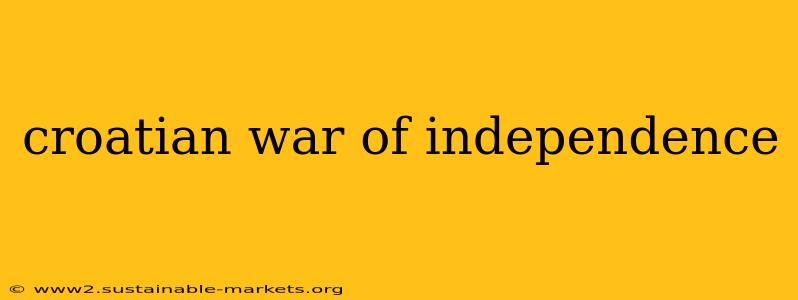The Croatian War of Independence (1991-1995) was a brutal and complex conflict that reshaped the political map of Southeastern Europe. This period of intense fighting saw Croatia declare independence from the crumbling Socialist Federal Republic of Yugoslavia (SFRY), triggering a bloody war with the Yugoslav People's Army (JNA) and Serb rebel forces. Understanding this conflict requires exploring its roots, key battles, international involvement, and lasting consequences.
The Seeds of Conflict: Nationalism and the Breakup of Yugoslavia
The disintegration of Yugoslavia wasn't sudden; it was a gradual process fueled by rising nationalism and long-simmering ethnic tensions. Decades of centralized rule under Josip Broz Tito masked deep-seated divisions between the various republics—Slovenia, Croatia, Bosnia and Herzegovina, Serbia, Montenegro, North Macedonia, and Kosovo. Tito's death in 1980 removed the unifying figure, and economic hardship exacerbated existing societal fault lines.
In Croatia, the rise of nationalist sentiment, particularly within the Croatian Democratic Union (HDZ) led by Franjo Tuđman, pushed for independence. Simultaneously, the Serbian minority in Croatia, fueled by fears of discrimination and a desire for autonomy, looked to Belgrade for support. This created a volatile mix of competing national aspirations, setting the stage for armed conflict.
The Role of the JNA
The JNA, initially intended to be a neutral force, increasingly sided with the Serbian leadership under Slobodan Milošević, who actively pursued the creation of a "Greater Serbia" encompassing significant territories within Croatia and Bosnia. The JNA's involvement in the conflict significantly escalated the violence, providing military support to Serb rebels and engaging in direct attacks against Croatian forces.
Key Battles and Military Campaigns
The war encompassed numerous key battles and military campaigns, each contributing to the overall narrative. Some of the most significant include:
-
The Battle of Vukovar (August – November 1991): This protracted siege became a symbol of Croatian resistance and Serbian brutality. The city's destruction and the numerous civilian casualties shocked the international community.
-
The Battle of Dubrovnik (October 1991 – May 1992): The shelling of the historic city of Dubrovnik by the JNA and Montenegrin forces drew international condemnation and highlighted the conflict's disregard for cultural heritage.
-
Operation Storm (August 1995): This large-scale Croatian offensive successfully reclaimed significant territory held by Serb rebels in Krajina, marking a turning point in the war. While a significant military victory, it was also marred by accusations of human rights abuses.
-
Operation Flash (January 1995): A successful Croatian military operation aimed at reclaiming territory in Western Slavonia.
International Involvement and the Dayton Agreement
The international community responded to the war with a mixture of hesitancy and condemnation. The United Nations deployed peacekeeping forces (UNPROFOR) to oversee ceasefires and protect civilians, but their effectiveness was often limited by the complex political dynamics and the competing interests of major powers. The European Community and the United States imposed sanctions on Serbia and Montenegro, but these measures had a limited impact on halting the fighting.
Ultimately, the war concluded with the Dayton Agreement (December 1995), which formalized the division of Bosnia and Herzegovina and established a framework for peace in the region. While it brought an end to the large-scale fighting, it didn't fully resolve the underlying ethnic tensions.
Lasting Consequences and Legacy
The Croatian War of Independence left a profound and lasting impact on Croatia and the broader region. The war caused widespread destruction, displacement, and loss of life. The economic consequences were significant, and the psychological scars of the conflict continue to affect the Croatian population. The war also had lasting geopolitical implications, reshaping the political landscape of Southeastern Europe and contributing to the ongoing instability in the Balkans. The legacy of the war continues to be debated and analyzed, with ongoing discussions about reconciliation, transitional justice, and the handling of war crimes. Understanding the Croatian War of Independence is essential for comprehending the complex history of the Balkans and the ongoing challenges to peace and stability in the region.

